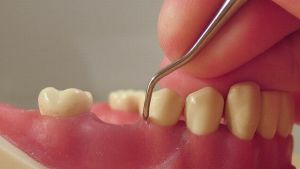 One of the dental problems is the formation of stones and other deposits in the periodontal pockets, the removal of which must be carried out in the shortest possible time.
One of the dental problems is the formation of stones and other deposits in the periodontal pockets, the removal of which must be carried out in the shortest possible time.
The reasons for this violation are food without rules, and water without quality( and more often - replacing it with other, sweet drinks), and an elementary ignorance of the methods of proper dental cleaning, and chronic infection of the oral cavity, shifting the chemical balance in the mouth to the acidic side.
And there are very few lucky people on the planet who do not know what tartar is-this hard core, as if embedded into the tooth, at the place where the crown passes into the gum, gently called the neck of the tooth.
Contents
- Dental stone steals your beauty and health
- Different techniques for
- What is the difference between the two methods?
- Stages of closed curettage
- Clearing of pockets of gums open method
- Possibility of complications
- Expert opinion of
- Immediately after the operation. ..
- In the Russian Federation it costs. .. But it's worth it!
Dental stone steals your beauty and health
But, in addition to purely aesthetic inconveniences, tartar is also a thief who has climbed into someone else's pocket. The pocket formed between the edge of the gum and the neck of the tooth, called the gingival or periodontal, is a slot-like space that normally has a depth of 2-3 mm.
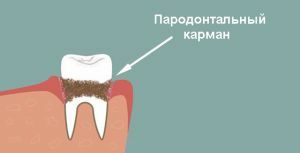
What is it that steals tartar? Neither much nor little is the life of a tooth. After grooving the neck of the tooth( here its thickness is maximal), the tartar, continuing downward( with a smooth decrease in the thickness of its layer), "dives" into the gingival pocket.
Here, the thickness of its layer gradually comes to naught, and on the sectional diagram its "wedge" is clearly visible, as it gradually grows down the thinning and "ripping" gum from the tooth's neck.
When the depth of the periodontal pocket is increased by a stone to 4-5 mm, it is quite enough to remove this hard dental "crust" to grow the gum to the tooth.
But the more time passes, the stronger the tooth is exposed: first - to the neck, then the exposure of its roots begins. The tooth, which is weaker connected with the gum, staggers ever more and may even fall out.
To prevent this phenomenon and to stimulate the growth of the gum to the tooth, at a depth of the periodontal pocket of 5-7 mm, removal of the calculus is performed with polishing of the exposed roots. But the conditions of life do not change, and with the continuation of the build-up of deposits, the problem becomes even more serious.
Because of the pressure of the calculus on the gum tissue, it slowly atrophies, "retreats", "sits down", falling in height.
The thickness of this jaw-covering tissue is gradually decreasing, and the atrophy of the bone tissue of the socket starts already, in which the tooth is immersed - not only the exposed tooth and gum around it is destroyed, the entire jaw suffers.
When the depth of the gingival pocket reaches 7-9 mm, only urgent curettage of the periodontal pocket can save the situation, which begins with the removal of hard dental deposits, which can not be removed.
Various techniques of
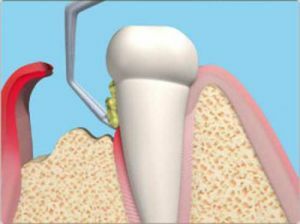 The curettage of the periodontal pocket is to restore its structure, as well as the functions of teeth, gums and jaws through microsurgical intervention.
The curettage of the periodontal pocket is to restore its structure, as well as the functions of teeth, gums and jaws through microsurgical intervention.
Achieved this goal by cleaning the gum pockets, not only from the stone between the tooth and gum - there is accumulated and softened tooth cement, and pus, and microbes.
There is also the formation of granulation tissue, which contains a large number of osteoclasts - cells that cause bone resorption.
Depending on the depth of the gingival lesion and the amount of surgical intervention, the curettage of the periodontal pocket is closed and open.
What is the difference between the two methods?
With the open curettage produced at the depth of the periodontal pockets from 4 to 6 mm, to ensure wide access to the operative space, the gums are cut with the detachment of its seam, after the pockets are cleaned, seams are placed on the gum.
When the curettage is closed( cleaning the periodontal pocket depth of 3 to 4 mm), the gum is not cut.
An unconditional advantage of the technique is that it allows not only purification of the gingival pockets, but also radical sanitation of microbial foci that are inaccessible by therapeutic methods of treatment, and this is a huge "plus" in the treatment of dental infections.
But every method of curettage has "minuses":
- with open there is a need for an operation with all the ensuing negative feelings and possible consequences;
- with closed the gingival pocket is processed "blindly" and therefore there can not be a full guarantee of its high quality.
Stages of closed curettage
For this microsurgical intervention, both mechanical and ultrasound instruments, as well as antibiotics of local( non-systemic) action, can be used.
Steps step by step:
- visual and radiographic assessment of the condition of the problem teeth and the adjacent gum line;
- application of local anesthetic;
- cleansing cavities of periodontal pockets( without dissection of gum tissue);
- polishing root of teeth;
- application on treated surfaces of antiseptic.
The capabilities of the method are limited both technically( work blindly), and the amount of work( processing of pockets no more than 2-3 teeth at a time).
Time / frequency of the procedure: at least 1 hour / 1 time per year, no age restrictions.

Clearing the pockets of the gums with the open method
In addition to profound revision and effective cleaning of the periodontal pockets, open curettage allows to restore the integrity of the gingival tissue of the gum.
The operation involves preparation in the form of removal of visible dental deposits, preliminary anti-inflammatory therapy, splinting( if necessary) groups of teeth, as well as combination with antibiotic therapy.
Gum cleaning steps:
- Assessment of the problematic teeth of with the adjacent segment of the gum, which includes 7-8 teeth( radiographic and visual).
- The mucosa is cut( under local anesthesia) along the line of the interdental papillae( in order to expose the necks of the involved teeth) and the mucous membrane is detached from the teeth and gingival bone with the formation of two of its grafts.
- Radical cleansing of the necks and roots of the teeth from the tartar ( ultrasound scaler) and scraping of the granulation tissue( surgical curettes).
- After the antiseptic treatment of the surfaces of the roots of the teeth and gums in the affected cavity of , the is transplanted - a "replanting" of the bone-forming material: the bone of the own or donor bone, the animal's bone or synthetic material. Transplantation not only allows you to strengthen your teeth in the gums, but also to stimulate the regeneration of the gum of your own bone tissue.
- The final step of the operation is the return of the gum flaps to the site of the by suturing them( overlapping the interdental spaces) and applying( for 3 days) an aseptic gingival dressing to protect the operated area. Seams are removed 10 days after the operation.
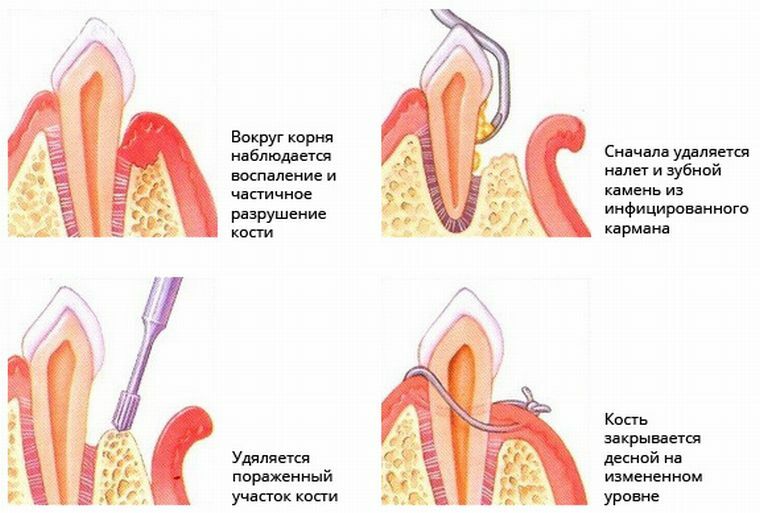
With the curettage of the gingival pockets made with the use of a laser device, the efficiency of the operation is increased many times due to:
- of a high degree of sterility of the operating field;
- rapid tissue coagulation with a minimum of blood loss;
- increase the level of controllability of processes occurring in the operating field.
How the gum pockets are treated:
Possible complications of
With closed curettage of periodontal pockets, complications are unlikely. 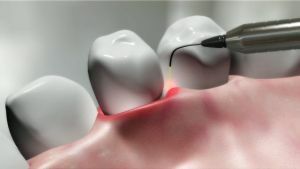
After conducting an open intervention, the exposed tissues can react to mechanical and chemical irritation:
- with swelling and local soreness;
- by inflammatory changes;
- increase in sensitivity( in case of removal of the altered properties of cement and dentin tooth).
Expert opinion of
As an expert who can hardly be called a novice in this field of medicine( experience of a dental surgeon for more than 10 years), I think that the use of closed curettage is justified only in the most basic cases( not complicated by serious pathology).
With a deep-seated process, it is not necessary to talk about its effectiveness - here the choice of curettage of periodontal pockets has always been and always remains the means of choice, allowing the oral cavity to be sanitized quickly, efficiently and radically.
Modern versions of the method( vacuum, laser, cryogenic) allow to make the operation even less traumatic and to reduce the number of complications.
Savelyev Yu. G., St. Petersburg
It is difficult to convince a patient of the need for such a "bloody" operation as an open curettage of periodontal pockets.
But after seeing the radiographs of a distressed picture of their own teeth and viewing other people's pictures taken before and six months after the operation, the patient agrees to such a radical measure. Then he says "thank you".And it's always nice!
Vladimir, dentist( Murmansk)
Immediately after the operation. ..
Reviews of patients who underwent curettage of periodontal pockets.
For a long time I suffered staggering teeth, but the doctor convinced that the matter is fixable. Curettage is not very pleasant, but now I cheerfully! Thank you Doctor!
D. Egorov, 44 g, Norilsk
He went on a terribly long operation( for repair of six teeth took two and a half hours) - curettage of the teeth of the lower jaw.
I looked at various frightening kinds of tools, then I could not close my mouth for a long time, my teeth felt for a very long time, they ached - neither eating nor smoking. So in fact also has thrown! Now the teeth do not stagger, and it's no shame to smile. Who wants to quit smoking. .. a little expensive, of course, but - with a guarantee!
Nikolay, 52 g, Ekaterinburg
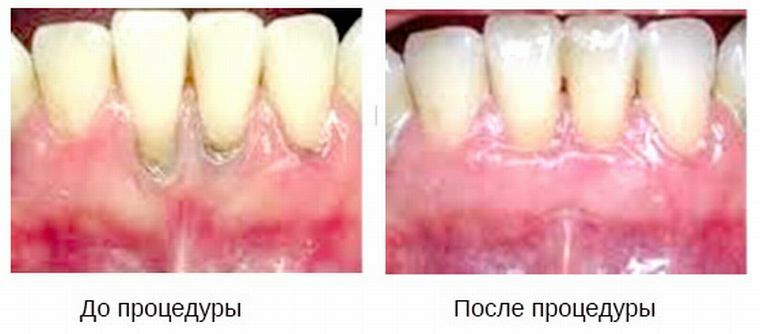
In the Russian Federation it costs. .. But it's worth it!
The cost of a closed curettage periodontal pocket( one) is an average of 1390 rubles.
Open curettage( one tooth) costs 2690 rubles( the price includes the cost of an unparalleled suture and material for transplantation into the gum tissue).
But the feedback from grateful patients convince: it's not too expensive.
